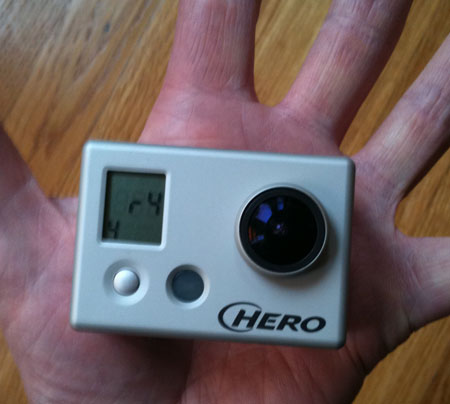GoPro Hero HD: Wearable Digital Video Cameras

To see more amazing video like the base jump above, a quick search on youtube or other video sharing website under the tag gopro will yield all sorts of sporting footage. GoPro make wearable video cameras designed to capture sports footage which are also designed to be attached to the outside of high velocity racing vehicles, onto boats and surfboards and just about any other use you can think of.
These cameras can capture at various different resolutions of HD video and images, and are very widely used in the sporting world. As their popularity has increased they are being used by network television and ad footage for those close-to- the-road action shots and other action shots.
Flip cameras, with their ease of use and portability are useful to capture meetings and events are terrifically useful, but the GoPro is unprecedented as a device for capturing and sharing real time usage footage for any sort of activity involving movement and activities.
If you're working in a large industrial plant and need to shoot first person video as you climb a 200 rung ladder to inspect a piece of machinery in windy conditions, recording it with a piece of equipment designed to do this task and with appropriate fittings to attach it to your hard hat will make that a lot easier.
Similarly recording footage of a vehicle suspension working at 130 mph, or the effect of wind speed on bodywork is what the goPro is designed for. The quality of footage, and in the newer versions, quality of audio is superb. In many forms of collaboration, visual reference in the form of video footage and timed photographs is central to project progress, and using this tiny device in challenging physical settings is extremely useful.
 GoPro's aren't particularly easy to set up and record with compared to a Flip camera: you have to button press to calibrate to the correct setting, watching a small screen on the front of the unit for the correct setting digits for your needs. The paperwork that comes with the camera isn't terribly intuitive either but fortunately this is a web video age device and there are plenty of 'how to use' videos uploaded by users and merchants.
GoPro's aren't particularly easy to set up and record with compared to a Flip camera: you have to button press to calibrate to the correct setting, watching a small screen on the front of the unit for the correct setting digits for your needs. The paperwork that comes with the camera isn't terribly intuitive either but fortunately this is a web video age device and there are plenty of 'how to use' videos uploaded by users and merchants.
All videos start and end with the user peering at the screen to set up and turn the unit on and off - there's an entertaining news story about a professor at Trevecca Nazarene University whose GoPro fell off a weather balloon sent up to the edge of the earth's atmosphere. The person who found the device - intact in its water and shock proof case - was able to read the professor's name badge and return it to him in the mail. The university was able to retrieve all the timed images taken at the edge of the planet.
I won't detail all the features and settings in this post since they are comprehensively outlined on the GoPro site, along with the various fittings for attaching it to various parts of yourself, your sporting gear or the machine you are operating.
Of particular note are the high quality slow motion abilities, which make trouble shooting and fine tuning fast activities much easier. There's some jaw dropping footage of motor racing, mountain biking and other activities on the GoPro website. These days you can often see the little red Hero lights flashing on Northern California surfer's boards as they paddle out in search of the perfect wave - now they can capture and share their better breaks for posterity....